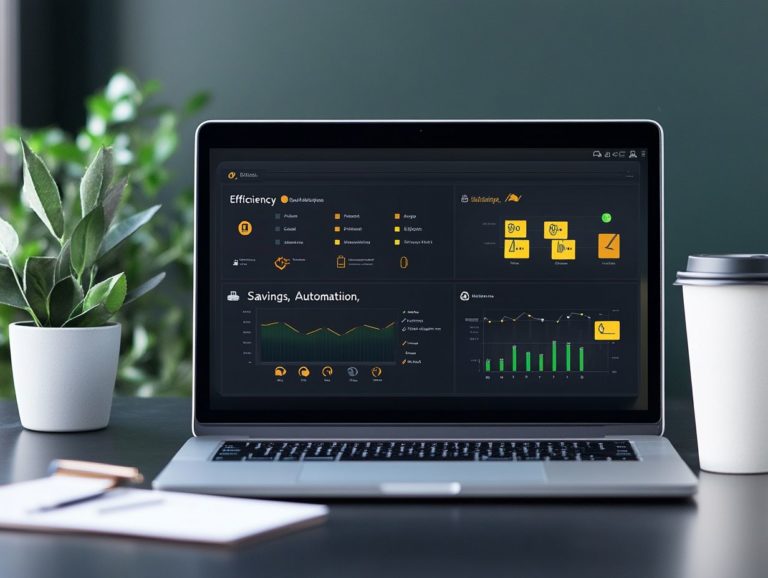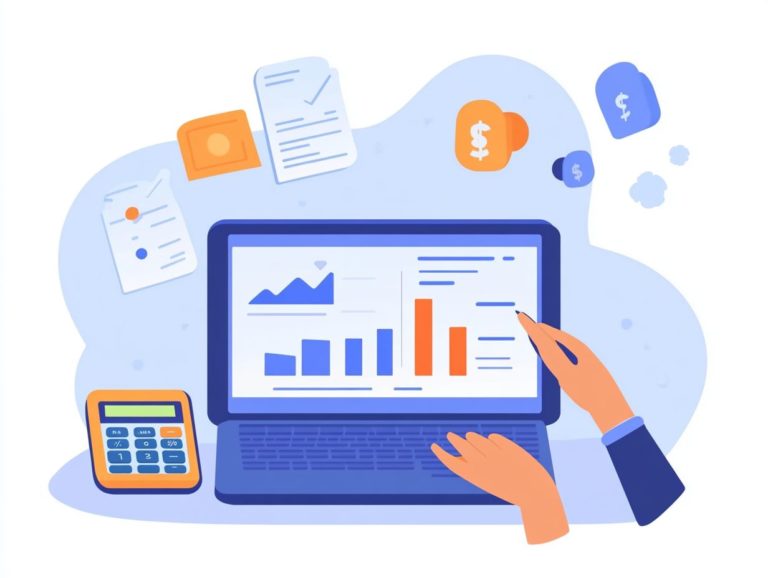Common Pitfalls in Cloud Cost Management
Navigating the complexities of cloud cost management can indeed feel overwhelming, particularly with the lurking threat of unexpected expenses. You may find yourself confronting familiar pitfalls, such as underestimating costs, neglecting optimization tools, and lacking effective usage monitoring. Let s explore these missteps and share best practices that will help you keep your cloud spending efficient and sustainable!
From strategically allocating resources to promoting collaboration within your teams, you ll gain valuable insights that will empower you to manage costs more effectively and maximize your cloud investments.
Contents
- Key Takeaways:
- What is Cloud Cost Management?
- Common Pitfalls to Avoid
- Best Practices for Effective Cloud Cost Management
- Frequently Asked Questions
- What are some common pitfalls in cloud cost management?
- How does overspending on resources occur in cloud cost management?
- What does it mean to optimize costs in cloud cost management?
- Why is it important to understand pricing models in cloud cost management?
- How Can Monitoring Usage and Costs Help in Cloud Cost Management?
- What Are Budget Alerts in Cloud Cost Management?
- What Are Some Cost Management Tools and Strategies?
Key Takeaways:

- Underestimating cloud costs can lead to unexpected expenses and budget overruns.
- Thoroughly analyze and forecast costs before moving to the cloud.
- Utilize cost optimization tools, such as auto-scaling and reserved instance discounts, to reduce cloud costs.
- Avoid overprovisioning resources to prevent wasted money.
- Regularly review and adjust resource allocation to match actual usage.
What is Cloud Cost Management?
Cloud Cost Management involves a comprehensive array of practices designed to optimize your cloud spending, ensuring financial efficiency within your organization as you leverage cloud computing technologies. This requires the collaboration of financial analysts and cloud architects who carefully track and review cloud expenses, pinpoint cost anomalies, and enhance resource utilization.
As your company increasingly migrates to cloud services, managing IaaS costs effectively becomes essential for maximizing the value of your cloud investments while minimizing waste.
Common Pitfalls to Avoid
When you’re managing cloud costs, it’s easy to stumble into common pitfalls that can cause unexpected expenses and inefficient resource allocation. Overlooking cloud waste and neglecting to utilize tools for understanding cloud cost anomalies can lead to overspending and subpar budgeting practices.
A lack of visibility into your cloud operations can hinder your understanding of expenditures and resource usage, making it challenging to navigate cloud cost complexity effectively.
Underestimating Costs
Underestimating costs is a common pitfall you may encounter in cloud cost management, often resulting in budget overruns and financial inefficiencies. To tackle this challenge head-on, consider adopting advanced forecasting models that offer a clearer view of potential expenses. By leveraging these models and focusing on key metrics for cloud cost management, you can analyze usage patterns and historical data, allowing for more accurate predictions of future costs.
Maintaining diligent budgeting practices where you continuously monitor and adjust expenses is crucial for sustaining your financial health. Proper cost allocation across departments not only fosters accountability but also helps you avoid unforeseen financial pitfalls that could disrupt your growth plans.
By cultivating a culture of financial awareness and utilizing sophisticated tools, you can make informed decisions that align your cloud spending with your organizational objectives.
Not Utilizing Cost Optimization Tools
Neglecting cost optimization tools, such as AWS Cost Explorer—a tool from Amazon Web Services that helps you analyze and manage your cloud spending—along with other cloud management software, can significantly impair your organization’s ability to effectively manage cloud expenditures. To understand the future of cloud cost management, it’s crucial to leverage these vital resources; otherwise, you may overlook valuable insights into your spending patterns, which can lead to a misallocation of cloud resources.
By integrating cost optimization tools, you can pinpoint potential areas for savings and streamline your expenses, paving the way for smarter financial management. These tools provide features like usage monitoring, budgeting, and forecasting, which enable you to make informed decisions about your cloud infrastructure.
In doing so, you not only enhance cloud efficiency but also optimize resource utilization, allowing you to allocate funds where they matter most and drive your organization toward operational success.
Overprovisioning Resources

Overprovisioning resources is a common problem in cloud systems where organizations allocate more than they need. This can waste resources and inflate operational costs.
This not only drains your budget but also creates operational inefficiencies. Excessive resources can clutter your management process and complicate resource allocation.
To mitigate these risks, it’s essential to closely monitor your resource utilization and consumption patterns. By implementing effective monitoring tools, you gain valuable insights into usage metrics, enabling informed decisions.
Strategies like labeling your cloud resources can help you identify and categorize assets, ensuring your team actively decommissions unused resources. Regular audits and adjusting scaling policies are invaluable for optimizing resource allocation without compromising performance.
Not Monitoring Usage and Performance
Neglecting to monitor your usage and performance metrics can waste resources and increase costs for your organization, making it crucial to understand how to reduce unexpected cloud costs.
In today’s rapidly evolving digital landscape, the importance of comprehensive performance tracking and cloud monitoring can’t be overstated. Prioritize these practices to keep your cloud environments optimized and cost-effective.
By using tools like cloud management platforms and monitoring solutions such as AWS CloudWatch or Azure Monitor, you gain a holistic view of resource consumption. Pairing these technologies with alert systems and regular audits can greatly enhance your cloud visibility.
Actively managing performance metrics and tracking usage patterns allows you to make informed decisions that improve operational efficiency and enhance service delivery and customer satisfaction.
Ignoring Unused Resources
Ignoring unused resources in cloud environments can waste your resources and money let’s not let that happen! This oversight can significantly impact your organization s financial health.
Effectively identifying and managing dormant resources can lead to substantial cost savings and optimize cloud performance. Advanced monitoring tools and automated management strategies help pinpoint and decommission underutilized services and instances.
Regular audits and resource labeling provide clarity on usage patterns, enabling more strategic allocation of your cloud resources.
These practices enhance cost efficiency and improve overall cloud operations, making them leaner and more responsive to your business needs.
Best Practices for Effective Cloud Cost Management
Implementing best practices for effective cloud cost management is crucial for organizations aiming to optimize cloud investments and achieve financial efficiency.
- Strategic budgeting techniques
- Comprehensive cloud cost analysis
- Enhanced collaboration among teams
These practices align your technology initiatives with your overarching business objectives for optimal results.
Proper Resource Allocation
Proper resource allocation is a cornerstone of effective cloud cost management, ensuring your cloud resources are utilized efficiently and align seamlessly with your business needs.
By using advanced cloud optimization tools, you can assess resource usage patterns and dynamically adjust allocations as your business objectives evolve. This proactive approach enhances performance and significantly reduces unnecessary expenditures.
Aligning your resource allocation strategies with business goals allows you to prioritize spending on services that truly drive growth and innovation. Ultimately, optimizing these resources fosters a more agile IT infrastructure, paving the way for improved operational efficiency and a stronger competitive edge in the marketplace.
Regular Monitoring and Optimization

Regularly monitoring and optimizing cloud costs is essential for staying ahead of your cloud consumption. This ensures well-informed financial decisions.
In today s rapidly evolving digital landscape, leveraging cloud management tools is crucial. These tools help businesses maintain efficiency without breaking the bank.
They provide insights into resource usage, allowing you to identify underutilized or misallocated resources.
By embracing continuous performance tracking, you can quickly identify cost-saving opportunities. This includes unused instances or services, helping you refine your strategies accordingly.
This proactive approach enhances financial stewardship and aligns cloud usage with evolving business objectives. Ultimately, it maximizes returns on your cloud investments.
Implementing Cost Management Tools
Using robust cost management tools like AWS Cost Explorer is essential. These tools give you a clear view of your cloud spending and improve your financial oversight.
They offer comprehensive dashboards that present real-time spending data, simplifying cloud financial management.
With advanced analytics and reporting features, you can identify spending trends and spot potential cost anomalies effortlessly.
Automated alerts and recommendations assist you in managing your budget proactively. This ensures that unexpected charges don t derail your financial plans.
Leveraging these resources helps maintain strict budget control while uncovering optimization opportunities for significant cost savings across cloud infrastructures.
Collaboration and Communication with Teams
Effective collaboration and communication among your teams are vital for successful cloud governance. This also optimizes financial efficiency in your cloud investments.
Bridging the gap between technical and financial teams cultivates a cohesive strategy. This strategy aligns cloud objectives with broader business goals.
Establishing regular meetings and collaborative workshops enhances understanding. It ensures everyone is aligned on the financial implications of managing cloud resources.
Leveraging shared dashboards visualizes technical performance and cost metrics. This makes complex financial data accessible to all stakeholders.
Encourage a culture of transparency! Open discussions about finances lead to better decisions and smarter cloud investments.
Frequently Asked Questions
What are some common pitfalls in cloud cost management?
Common pitfalls in cloud cost management include overspending, poor optimization, and a lack of budget alerts. Additionally, factors affecting cloud cost management like not understanding pricing models can lead to unexpected costs.
How does overspending on resources occur in cloud cost management?

Overspending can happen when businesses overprovision resources, pay for inactive resources, or miss cost-saving opportunities like reserved or spot instances.
What does it mean to optimize costs in cloud cost management?
Optimizing costs means finding ways to reduce expenses while meeting business needs. This can include adjusting resources, using lower-cost instance types, and implementing cost-saving strategies like autoscaling.
Why is it important to understand pricing models in cloud cost management?
Understanding pricing models is vital because different providers have unique pricing structures. Not understanding these can lead to unexpected costs. This knowledge helps businesses choose the most cost-effective services for their needs.
How Can Monitoring Usage and Costs Help in Cloud Cost Management?
Monitoring usage and costs helps businesses track their cloud spending. It identifies areas where they may overspend and enables better resource management.
What Are Budget Alerts in Cloud Cost Management?
Budget alerts notify businesses when they near or exceed their spending limits. These alerts allow for timely adjustments to avoid overspending.
What Are Some Cost Management Tools and Strategies?
Effective cloud cost management tools include cloud cost platforms and resource tagging. To learn more about strategies such as rightsizing, reserved instances, spot instances, autoscaling, and cost allocation, check out how to implement cloud cost controls, as they all play a vital role.
These tools help businesses control and optimize their cloud spending efficiently.






